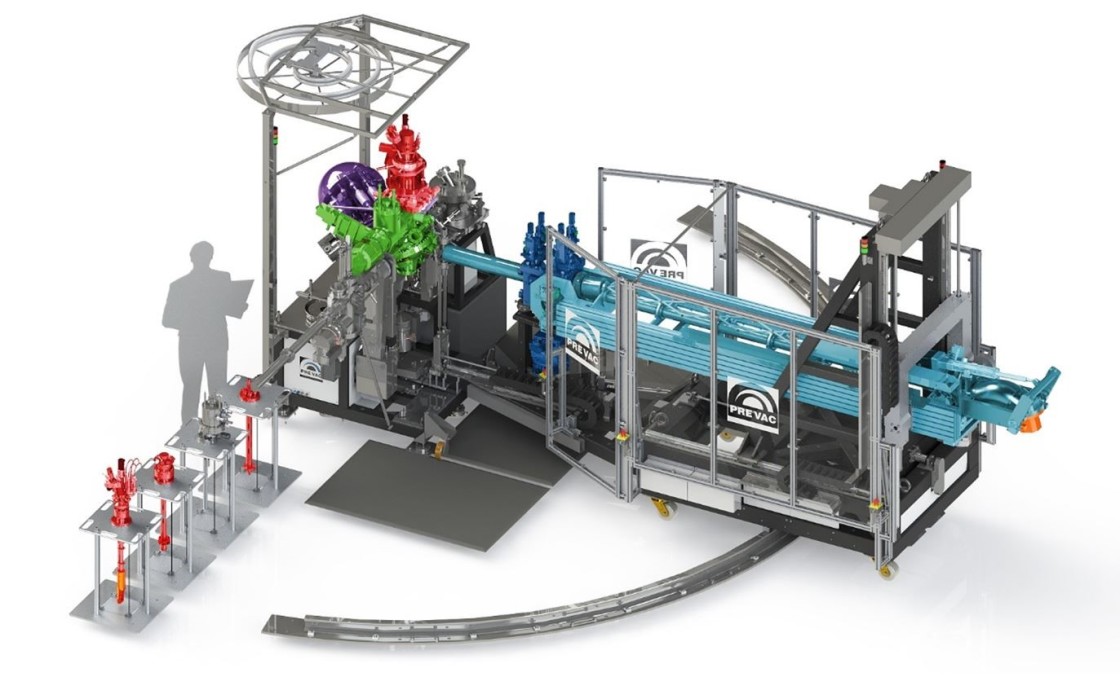Department Dynamics and Transport in Quantum Materials
PEAXIS: The end-station for Photo Electron Analysis and X-ray Inelastic Spectroscopy at BESSY II
PEAXIS is dedicated to soft x-ray spectroscopy studies on the electronic structure of novel energy materials. It offers capabilities for soft X-ray Resonant Inelastic X-ray Scattering (RIXS) and Angular Resolved Photo Emission Spectroscopy (ARPES) on bulk and thin-film solid state samples. RIXS in particular can be used to study the local electronic structure at element and orbital specific atomic sites and yields wavevector-resolved information about dynamics of collective excitations.

Fig. 1: Layout of the PEAXIS spectrometer, which was built by the company PREVAC, Rogów, Poland. The station is equipped with an electron energy analyzer (violet) and a RIXS spectrometer (blue). Various sample manipulators (red) can be mounted to the sample chamber (green) according to different sample environments. The RIXS spectrometer includes a grating chamber (dark blue), a five-meter RIXS arm (light blue) and a CCD detector (orange). The distance between sample and grating as well as between grating and detector is variable. For q-dependent measurements the RIXS arm can be continuously rotated around the sample in a range of 106°.
Instrument Features
- PEAXIS is the first RIXS end-station at BESSY II that allows measurements with high energy resolution in combination with a continuous variation of the scattering angle under UHV conditions [1-3] for wavevector-resolved studies.
- A modular sample environment enables measurements in the temperature range between 20 K and 1000 K. The low-temperature manipulator is well matched to the requirements of magnetic systems, while catalytic studies can be performed in an intermediate temperature range and thermoelectric materials can be studied under operating conditions at high temperatures.
- Additional ARPES capabilities.
- With the soft X-ray penetration depth typically ranging from 100 nm to 10 μm in the energy range from 200 eV up to 1200 eV, RIXS at PEAXIS is considered to be bulk-sensitive.
Unique applications of RIXS
Electron-phonon coupling: The intensity of phononic excitations in RIXS spectra is directly proportional to the electron-phonon coupling strength, a parameter not directly accessible with other techniques. This unique feature is of particular interest for studies on thermoelectric materials where coupling of lattice degrees of freedom to the electronic structure has a direct influence on the thermoelectric performance.
Dispersive excitations at high energies: Inelastic measurements with photons provide access to the high-energy part of dispersion, which may assist microscopic modeling of elementary excitations.
Nanostructured and thin film samples: RIXS allows dynamical studies on samples displaying confinement effects, allowing to elucidate the effect of finite-size, nanostructuring and low dimensionality on material properties respectively electronic states.
Magnetic excitations: RIXS can also be used to study magnetic excitations in a variety of materials ranging from model materials for fundamental research to functional energy materials, e.g. spin-caloric systems. It is a complementary technique to the more traditional method of inelastic neutron scattering; a much deeper understanding of the physics of magnetic systems can be obtained by combining these two methods. In particular, RIXS is able to probe parts of the Brillouin zone where the neutron cross-section is too low to produce a measurable signal, e.g. around the Γ-point. RIXS is also able to measure higher energy excitations e.g. in the cuprates, which form the basis of many exotic high temperature superconductors and quantum magnets. In such systems the excitations can extend beyond 100 meV, becoming inaccessible to most neutron spectrometers. Furthermore, since the RIXS method relies on adjusting the x-ray energy to match the resonant energy of a specific element, it can identify the specific element responsible for orbital order, which neutrons are unable to do. Therefore, RIXS can be used for crystal field studies. This is particularly important in the emerging field of 4d and 5d oxides, where both spin-orbit coupling and crystal field play an important role and give rise to exotic states of matter.
PEAXIS is a fixed experimental station installed at the U41-PEAXIS beamline. More information can be found also on the IGAMA web page of PEAXIS. Software designed for the PEAXIS instrument can be found here.
References
[1] C. Schulz, K. Lieutenant, J. Xiao, T. Hofmann, D. Wong and K. Habicht, Characterization of the soft X-ray spectrometer PEAXIS at BESSY II, J. Synchrotron Rad. 27, 238-249 (2020).
[2] K. Lieutenant, T. Hofmann, C. Schulz, M. V. Yablonskikh, K. Habicht, E. F. Aziz, Design concept of the high-resolution end-station PEAXIS at BESSY II: Wide-Q-range RIXS and XPS measurements on solids, solutions, and interfaces, J. Electron Spectrosc. Relat. Phenom. 210 (2016) 54–65.
[3] K. Lieutenant, T. Hofmann, C. Zendler, C. Schulz, E. F. Aziz, K. Habicht, Numerical optimization of a RIXS spectrometer using raytracing simulations, J. Phys. Conf. Ser. 738/1 (2016) 012104.

